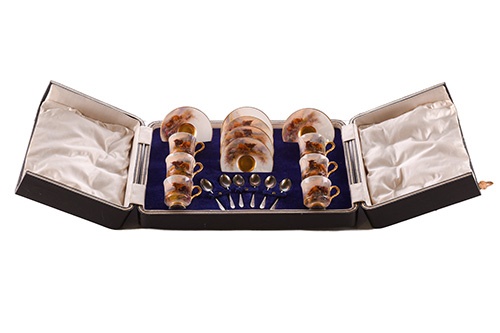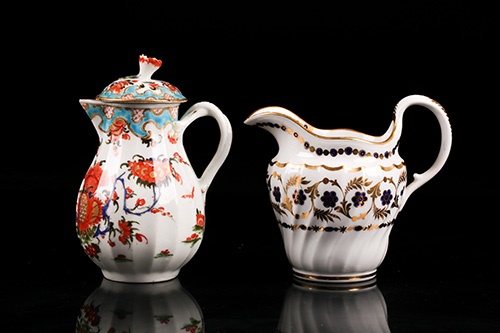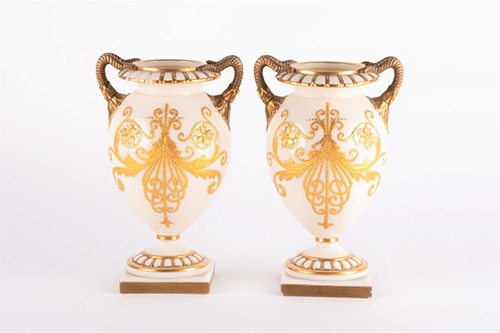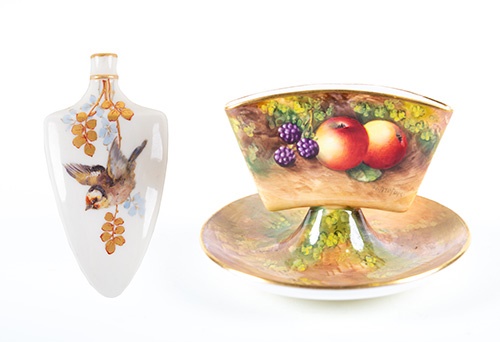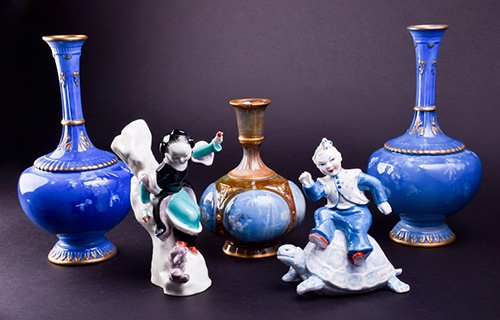A guide to early Worcester Porcelain
The pioneers of artistic and industrial revolution
28/10/2022
Considered by experts to be one of the earliest porcelain manufacturers in England, Worcester Porcelain was founded in 1751 by physician, John Wall, and apothecary, William Davis. After more than a century of growth, in 1862 the company became the Royal Worcester that we know today, due to a number of commissions from members of the royal family.
Worcester Porcelain is known for its reputable designers and artists, past and present, each bringing their own personal touch to their designs, and creating unique and highly collectable pieces.
EARLY HISTORY
In mid 18th century England, the cogs of industrial revolution were beginning to turn, completely transforming Britain economically and socially.
Worcester was one of the pioneering cities in this great transformation. Understanding the national need to create more employment opportunities for the working class, Dr Wall had been fascinated by the development of chemical science within the porcelain industry and began looking for methods of making porcelain that would boost prosperity in the city.
An 18th century,(first period) Worcester porcelain fluted cream jug and cover
Before the revolution, the majority of the working class resided in the countryside, taking up traditional vocations in farming and agriculture. However, by the mid 19th centruy, the new manufacturing companies that had been established across Britain had created so many jobs that most of the working class had migrated to nearby towns and cities.
And so, with a designated backdrop of industrial revolution and exciting decorative art innovations taking place in Europe, Worcester began its porcelain manufacturing journey.
ORIENTAL INFLUENCES
The Oriental style of much of the early Worcester Porcelain was a product of the West’s dedication to replicating Chinese porcelain, due to a high demand across Europe.
A pair of Grainger Worcester ivory porcelain vases
Kaolin clay was the fundamental component of the hard paste used by the Chinese to make their pottery. However, Britain’s supply of the clay was limited and confined to the coasts of Cornwall, meaning British chemists and alchemists had to experiment with the chemical properties of the paste, in order imitate it.
A Worcester porcelain blue & white salad drainer
One of the first successful imitations was achieved by Benjamin Lund, who used Cornish soaprock to create a soft paste. The recipe was bought by Worcester Porcelain in 1752 and refined over the years to create the perfect material in which to replicate the designs of the Chinese.
Unlike the softer French and Chelsea porcelains that were far less Oriental in style, Worcester continuously worked to produce the most accurate and high quality imitations of Chinese hard paste to date; the success of which can be seen in the remarkable patterns and designs adopted in their pottery.
A Royal Worcester porcelain figure 'The Water Carrier'
More than any other Western manufacturer, it was characteristic of Worcester Porcelain to copy a lot of Oriental patterns and designs, even adding Chinese markings to many of their earlier pieces. Although they were by no means attempting to deceive anyone, their imitations were so artistically accurate that they are often mistaken for originals, highlighting the level of skill and craftmanship that Worcester were achieving even in their early years.
A Royal Worcester porcelain scent bottle
COLOUR
Colour has always been a prominent part of Worcester Porcelain, but with over 200 years of experience in mastering colour techniques, it has become one of the most exquisite features in the modern pieces.
The most iconic colours are the rich cobalt blue, ruby, opaque green, turquoise, and the bright enamel blue. The extraordinary clarity of the cobalt blue is something that has been developed over time, with earlier examples possessing a blackish hue as a result of impurities in the materials. Today, it is one of the most durable and beautiful colours used by Worcester Porcelain and one of their most definitive features.
A group of five Royal Worcester shot enamel porcelain figures emblematic of nations of the world
TRADEMARKS
Early Worcester Porcelain marks are renowned for being both rare and irregular. Changes in company leadership, design influences, and location of the factories meant that there was no consistent trademark until the royal stamp was introduced after 1862.
Early Worcester Porcelain marks are rarely seen - it is a blue crescent mark that typically dates pieces back to the ‘First’ or ‘Wall’ period (1751-1783). Due to their rarity, these pieces are highly prized and usually only found amongst collectors.

Additionally, on pieces preceding 1783, a cursive ‘W’ is marked to indicate the Wall period, along with other Chinese markings on the Oriental style pieces.
The more irregular marks found on earlier pieces, are assumed by specialists to be the individual signature marks of the workmen who produced them, hence their inconsistency.
Five items of Royal Worcester porcelain
From 1862 onwards, the individual markings were dropped, and the Royal Worcester stamp was introduced, offering what appeared to be a more systematic approach to trademarking. The pieces were labelled by year, using either numerical, alphabetical, dot, or star systems, depending on the period. However, these systems can still be confusing to the untrained eye, and it is always advisable to have your porcelain appraised by a known specialist to ensure it is dated accurately.
Have you got any Worcester Porcelain you are looking to sell?
Our team of experts are always happy to help appraise your porcelain.
We offer a complimentary valuation service and can also provide insurance valuations where required.
Get in touch with us today, we would love to hear from you.
0207 431 9445 / info@DawsonsAuctions.co.uk
